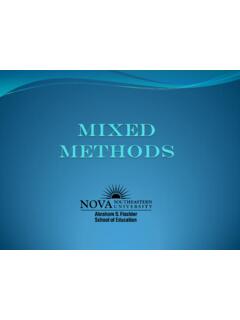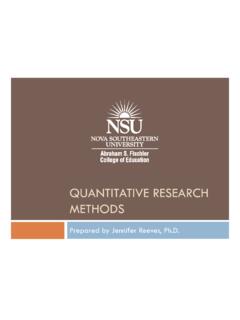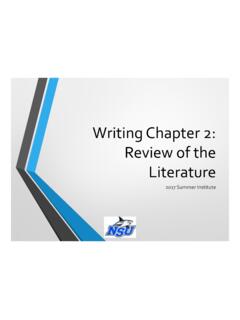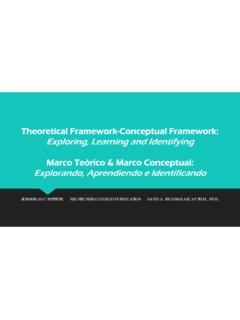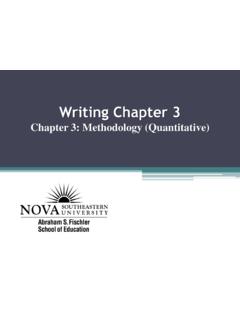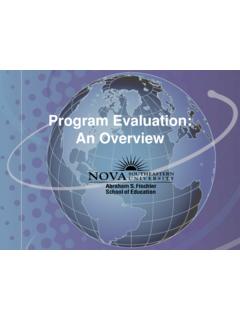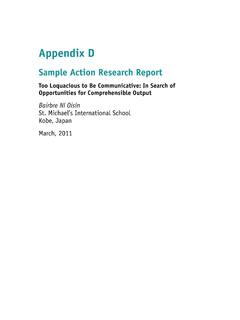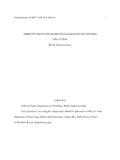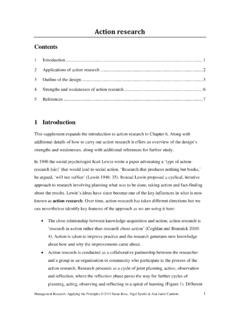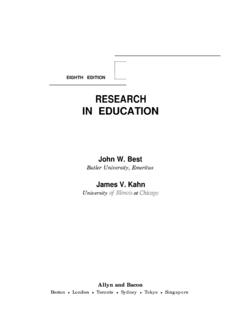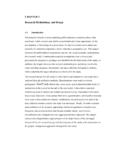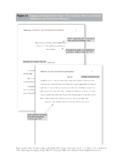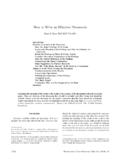Transcription of FROM PROBLEM STATEMENT TO RESEARCH …
1 FROM PROBLEM STATEMENT TO RESEARCH QUESTIONSO bjectives Understand and develop all of the Chapter 1: Introduction sections. Develop and articulate RESEARCH questions that are related to the purpose of the 1: IntroductionStatement of the ProblemThis should include (a) a clear STATEMENT that the PROBLEM exists, (b) evidence that supports the existence of the PROBLEM , (c) evidence of an existing trend that has led to the PROBLEM , (d) definitions of major concepts and terms (this can be provided below in a subsection), (e) a clear description of the setting, (f) probable causes related to the PROBLEM , and (g) a specific and feasible STATEMENT . The Topic This is a brief description of the proposed area of study. Include at least two RESEARCH ProblemThis is an area of conflict, concern, or controversy (a gap between what is wanted and what is observed).
2 Include the most relevant reference that supports the 1: Introduction (cont.)Background and JustificationThe evidence and relevance from the literature and published or archival data showing the PROBLEM exists. Include at least two references. You should also have a theoretical basis for the study. Deficiencies in the EvidenceInclude a brief discussion that details the area of need (in relation to the PROBLEM ) and the deficiency or lack of evidence in the who is affected and who of TermsProvide complete scientific definitions and appropriate references if necessary. Include as many terms or variables as of the StudyCreate a sentence that begins with The purpose of this study is .. Clearly identify and define the central concepts or ideas of the of the Flow of Ideas in the PROBLEM StatementTopicResearchProblemJustificati onfor RESEARCH ProblemDeficiencies in the EvidenceRelating the Discussionto AudiencesSubjectarea Concern or issue A PROBLEM Something thatneeds a solution Evidence from theliterature Evidence from practical experience In this body of evidence what ismissing or what do we need to know more about?
3 How will addressingwhat we need to knowhelp researchers, educators, policymakers, and other individuals?An ExampleEthical issues in collegesFlow of IdeasEthical violationsamong football recruiters Gap in the literature Reports of violationsDescription identifying and characterizing violations Assessing violations Helps recruiters developbetter ethical standards Helps athletes understand ethical issuesThe Topic is introduced in the first paragraphs. includes the general subject matter. must be introduced so that the reader can relate to Selection Considerations Personal interest Organizational support Ethical issues Relevance of the study Contribution to the field Time constraints Breath and scope Economic factorsSources of Topic Selection ERIC, PsycINFO, Medline Journals, books, and dissertations in your field Conferences, workshops, presentations Recommendations about future RESEARCH Courses Workplace Expert consultations Online library servicesWhy the RESEARCH PROBLEM Is Important It establishes the importanceof the topic.
4 It creates reader interest. It focuses the reader s attentionon how the study will add to the the RESEARCH PROBLEM State the PROBLEM in the opening paragraph ( , something that needs a solution) Identify an issue RESEARCH -based RESEARCH problems Practical problems reference the PROBLEM using the literature Common pitfall: defining the PROBLEM based on the solutionHow the PROBLEM Differs From Other Parts of RESEARCH A RESEARCH problemis an educational issue or PROBLEM in the study. A RESEARCH topicis the broad subject matter being addressed in a study. A purposeis the major intent or objective of the study. RESEARCH questionsare those that the researcher would like answered or addressed in the the Importance of the RESEARCH PROBLEM Justification based on what other researchers have found Justification based on personal or workplace experiences Justification based on the experiences that others have had in the workplaceLocating the RESEARCH PROBLEM Read the opening paragraphs of existing studies for one or more of the following: What is the issue or PROBLEM ?
5 What controversy leads to the need for a study? What concern is being addressed behindthe study? Is there a sentence such as, The PROBLEM being addressed in this study ?Determining Whether a PROBLEM Should Be Researched Can you study the PROBLEM ? Do you have access to the RESEARCH site? Do you have the time, resources, and skills to carry out the RESEARCH ? Should you study the PROBLEM ? Does it advance knowledge? Does it contribute to practice?Determining Whether a PROBLEM Should Be Researched (cont.) Will your study fill a gap or void in the existing literature? Will your study replicate a past study but examine different participants and different RESEARCH sites? Will your study extend past RESEARCH or examine the topic more thoroughly? Will your study give voice to people not heard, silenced, or rejected in society? Will your study inform practice?
6 How the PROBLEM Differs From Other Parts of RESEARCH A RESEARCH problemis an educational issue or PROBLEM in the study. A RESEARCH topicis the broad subject matter being addressed in a study. A purposeis the major intent or objective of the study. RESEARCH questionsare those that the researcher would like answered or addressed in the Deficiencies in the Evidence What do we still need to know? What else do we need to know to improve practice?Identify the AudienceAsk the following question: Who will profit from reading our study? Other researchers Practitioners Policy makers Special populations ( , parents)Elements of a QuantitativePurpose STATEMENT A quantitative purpose statementidentifies the variables, their relationships, and the participants and site for RESEARCH Guidelines for writing Use a single sentence. Use wording such as The purpose of this study.
7 If using a theory, state the theory you plan to test. Use quantitative words ( , relate, compare, describe ) to describe the relationships between of a Quantitative Purpose STATEMENT (cont.) Guidelines for writing (cont.) Independent variable (1st position in sentence) Dependent variable (2nd position in sentence) Control and/or mediating variable (3rd position in sentence) RESEARCH site ParticipantsQuantitative RESEARCH Questions Types of quantitative RESEARCH questions Describeresults of your variables. Comparetwo or more groups on the independent variable in terms of the dependent variable. Relatetwo or more variables. Guidelines for writing Pose a question. Begin with how, what, or why. Specify the independent, dependent, and mediating or control variables. Use the words describe, compare,or relateto indicate the action or connection among the variables.
8 Indicate the participants and the RESEARCH site for the QualitativePurpose Statements and RESEARCH Questions Understand how these statements and questions differ from quantitative RESEARCH . Understand the role of a central phenomenon in qualitative RESEARCH . Understand qualitative RESEARCH as an emerging Between Quantitative and Qualitative Purpose Statements and RESEARCH QuestionsQuantitative more cause/effect (Why did it happen?) Use of theories (Why did it happen in view of an explanation or theory?) Assess differences and magnitude (How much happened?) (How many times did it happen?)(What were the differences amonggroups in what happened?)Qualitative more open ended Descriptive (What happened?) Interpretive (What was the meaning to people of what happened?) Process oriented (What happened over time?)Explaining or Predicting Variables Versus Exploring or Understanding a Central PhenomenonQuantitativeExplaining or Predicting VariablesQualitativeUnderstanding or Exploring a Central PhenomenonX YThe independent variable (X)influences a dependent variable (Y)In-depth understanding of Y;external forces shape and areshaped by YYElements of Qualitative Purpose STATEMENT A single sentence A STATEMENT such as, The purpose of this study.
9 The central phenomenon A STATEMENT identifying the type of qualitative design Qualitative words ( , explore, understand, discover ) The participants The RESEARCH siteTypes of Qualitative RESEARCH Questions Central questionis the overarching question you explore in the RESEARCH study. Subquestionsdivide the central question into smaller, specific questions. Issue subquestions: Narrow the focus of the central question into specific issues. Procedural subquestions: Indicate the steps to be used in analyzing the data in a qualitative study. Interview questions are asked during your interview and are based on your subquestionsand central among the Topic, PROBLEM , Purpose, and QuestionsGeneralSpecificTopicResearchPro blemPurposeStatementResearchQuestionDist ancelearningLack of students in distance classesTo study why students do not attend distance education classes at a community collegeDoes the use of Web site technology in the classroom deter students from enrolling in a distance education class?
10 ExampleStatement of the ProblemThe Topic Distance education via online platforms is a rapidly growing method of education delivery due to its convenience, wide reach, relatively low cost, and ability to support the achievement of learning objectives. Whether the platform is Blackboard, WebCT, Moodle, Angel, or some other learning management system, online education utilizes a variety of common learning tools including discussion boards, drop boxes, automated testing, and wikis. Chief among these tools are live online RESEARCH ProblemLive online sessions may be delivered in virtual classrooms from Adobe Connect, Elluminate, GoToMeeting, Wimba, or other software programs. Regardless of the software used, student attendance at live online sessions, especially optional ones, can be unpredictable at best. It is a common complaint among the online faculty at a university in the south that many, oftentimes most, of their students do not attend the live online sessions.
